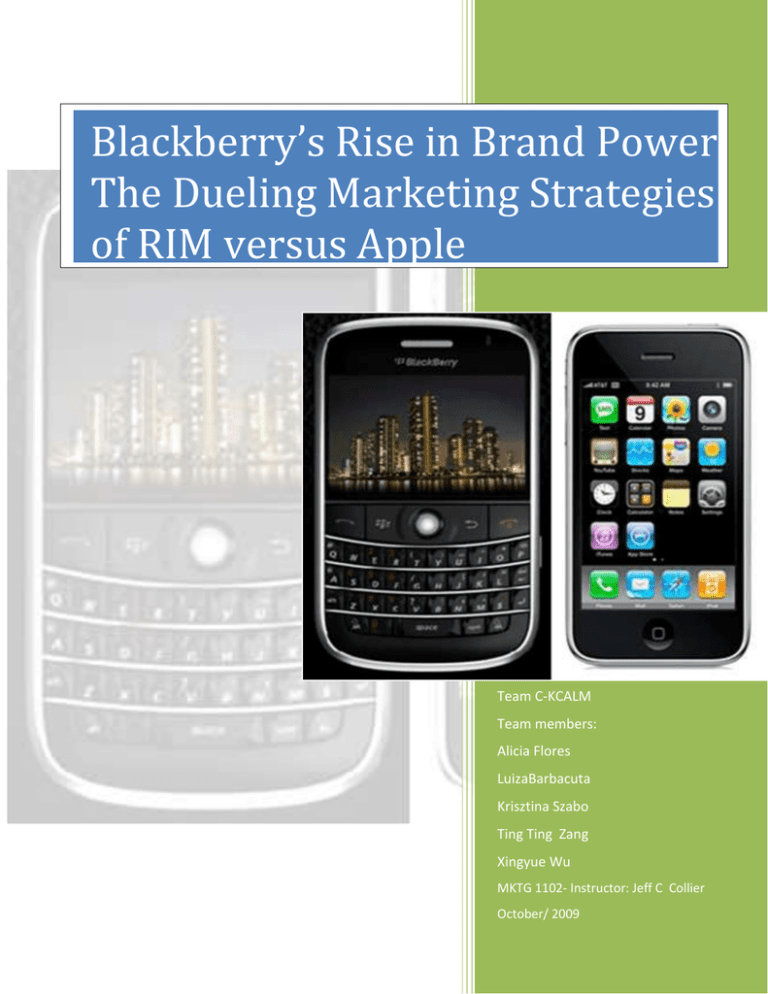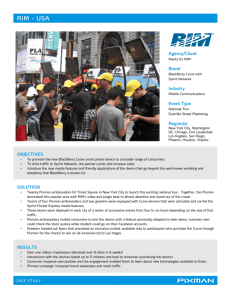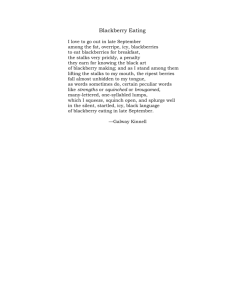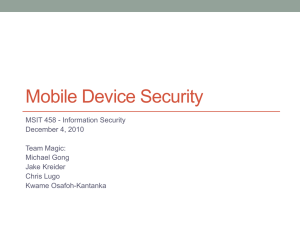Blackberry vs I-Phone
advertisement

Blackberry’s Rise in Brand Power The Dueling Marketing Strategies of RIM versus Apple Team C-KCALM Team members: Alicia Flores LuizaBarbacuta Krisztina Szabo Ting Ting Zang Xingyue Wu MKTG 1102- Instructor: Jeff C Collier October/ 2009 Introduction: Over the years, RIM has taken the Blackberry from just a simple pager to one of the leading smartphones on the market today. The evolution of the Blackberry from its early pager days to what we have today didn’t just happen over -night, it took many years of trial and error to develop this well put together product. The very first Blackberry, as we know it today, was developed in 1998, and RIM has continued to build and improve their idea ever since. However, with increasing pressure from competitors such as Apple with the iPhone (their version of a smartphone) the question of whether or not Blackberry has the staying power to be able to keep up with all the new competition weighs heavily on everyone’s minds. Problem: How can RIM maintain their strong hold on the smartphone industry with such a dramatic increase in competition? Key Findings: RIM is a Canadian based company, with a remarkable success story. From their humble beginnings out of Waterloo University in Ontario, to being named by Forbes Magazine as one the fastest growing companies in the world, RIM is a company that just keeps pushing forward. RIM has been able to expand and push their products onto the global market. In fact, 92% of all their revenues earned come from outside of Canada. Blackberry phones have been able to span a total of 150 different countries all over the world, perhaps this is why the sales in Q2, 2009 were high enough that Blackberry was able to secure 21% of the worldwide sales of all smartphones. Blackberry has been able to earn itself quite a bit a respect among consumers over the years, with their constant improvements to their product and overall reliability. By paying special attention to small details and developing innovative little touches like their security and remote administration functionality, it helps to give them an edge over other competitors. However, with increasing competition becoming more and more prominent, especially from Apple’s iPhone, Blackberry will surely being counting more and more on their customer loyalty to help carry them into the future. The Apple iPhone has been doing extremely well for such a new player on the smartphone scene. It has experienced such a great amount of success in such a short amount of time, it would be impossible for RIM not to take notice. The iPhone is more of a trendy, hip product geared towards a younger more youthful audience, whereas Blackberry phones have been more typically used in business and geared towards professionals. Now with the development of the Blackberry Storm, RIM will have a phone that will be in more direct competition with the Apple iPhone. Time will tell whether or not these two competitors will be able to live in harmony, or whether one will have to disappear from the market altogether. Assumptions: RIM has the resources they need in order to further develop their product line. SWOT Analysis: Strengths: The company provides strong technological support Reliable service and product Extreme customer loyalty Focus is very clear, aimed at business professionals Core products(blackberry series) Fastest growing company in the world Weaknesses: Lack of revolution or development for the product Too conservative by nature and not progressive As a result of conservation, they do not make big investments for marketing They are not sensitive to the competitors marketing strategy Limited market. Mostly English based markets. Opportunity: The trend of 3G and WIFI. Globalization. More and more people look at cell phones as not only a tool but also an entertainment device. Many talented people want to work in this field. Build firm relationships with communication networks and companies, for example, AT&T, ROGERS, T Mobile, China telecom) Threats: There are some big competitors (such as Apple) which provide similar features(mobile phone, e-mail, organizer, internet device, music) The big competitor, Apple, makes iPhone more attractive and fashionable than BlackBerry which has a more traditional look. Some competitors, like Apple, Sony, and HP, develop new phones to get the market share for the young generation. Apple invested huge amounts of money for advertising, developing market, and also developing new technology. Competitive analysis: Current/potential competitors: BlackBerry’s biggest competitor is, without a doubt, Apple’s iPhone. There are other competitors, like LG, Sanyo, Samsung, Motorola, Palm, Nokia, HTC and Sony/Ericsson, but none of them compete in the consumer market as strong as the iPhone. The study on the right shows customers satisfaction ratings with all companies. Apple’s iPhone, is stronger in popularity mostly because of the association people do with all other Apple’s products, like Mac computers, iTunes and iPods. These products are very popular with the younger generation. BlackBerry is very popular with business people, politicians and even popular with celebrities. Price wise, they are relatively equal, the difference between them depends from provider to provider, depends on the plans and contracts with the different providers. BlackBerry remains popular and is still in the race for first place, because of the email capabilities, the internet applications, SM card from Verizon which gives BlackBerry’s phones international roaming capabilities. Below is a list with some of the two phones features, which proves that from many points of view, BlackBerry is still better than iPhones. The success of both companies, RIM and Apple, will depend on the targeted market and on the variety of related products they’ll have. After looking at the pros and cons of both phones, the decision will be ultimately left to the individual’s taste. Blackberry Target Market: Corporate, business customers purchasing the vast majority of the BlackBerry devices and services. The BlackBerry has expanded beyond its roots as a wireless tool to read email, now offering such capabilities as business collaboration, social networking and the sharing of data and documents. Young individuals who like cool things, interact with friends, facebook etc.. People with the importance of mobility in foreign countries With the releases of its Pearl and Curve devices, RIM has attempted to break into the consumer segment. This, in turn, has enabled both handset manufacturers and wireless carriers to lower costs, making the BlackBerry more affordable to the average consumer. Recommendations Alternative # 1: Create a new series for a younger generation. The new series of phone will have a more fashionable look, colorful outside, as well as 3G and WIFI inside. But, at the same time, RIM should keep their classic series “BlackBerry” for business people. Advantages: RIM will diversify their product line. RIM will expand their target market to a younger generation and even more business people. Gain more income. Disadvantages: RIM needs to make some big investments for developing a new series phones. There is a high risk for expanding the product line. Alternative #2 Open Asia Pacific Market. First, build factories in Asia, provide a 2 year guarantee to each product, and lower the product’s price. Then, work on developing partnerships with the local wireless carriers (China mobile, DOCOMO, etc.). Third, invite local stars to do the commercials. Fourth, use multilingual operation systems and add more entertainment elements (cell phone KARAOKE…). Advantages: Greater number of potential customers. World’s biggest cellular market is in Asia, Japan and China. Increase brand impact and maintain brand reputation of great service. Create new image of BlackBerry as both professional and entertainment. Build a friendship with new customers by using well placed advertisements and provide good service. Decrease the risk of over depending on the U.S. market. As of 2008, 42% of RIM’s revenue came from the U.S. market. Disadvantages: High investment risk. The investment is huge and this is an unfamiliar market for BlackBerry. Hard to compete with the local cell phone companies. In Japan, over 80% of the market is shared by local cell phone companies. Highly dependent on technology. Different functions are required; different writing systems, games, water proof, etc… SMS message vs. E-mail. Most Chinese people prefer SMS and merely use cell phone to send email. Culture challenges. Alternative #3: Diversify product line and extend software products. Build new professionally developed and competitive sustainable advantages by creating new: Earphones New software Separate music device Computer line Advantages: Product: BlackBerry has knowledge, technology and resources on hand. They built a good brand name. Price: Their prices are affordable, and can go lower than their competitors Place: The BlackBerry provides a truly secure network, and critical business information, its safe everywhere around the world. They have good relationships with retailers internationally. BlackBerry’s intuitive menus and ease of use make it hugely popular. And it's a scalable solution, which makes deploying new users simple. Disadvantage: Promotion: Their advertising is not as strong as other competitors. They are not strong in promoting various available products for targeted customers. Solution: Diversify product line and extend software products. This strategy is recommended because BlackBerry has a big competitor company, Apple. The goal is not to copy their competitor’s product, but to develop new products that Apple doesn’t have and adopt new technology. Building professionally developed new products will help Blackberry to stay on top of their competition. Pros: Proven good quality products over the year Leading sales Good established brand name Extend customer relations Continue an international expansion strategy while also expanding product line Cons: Involves massive advertising, which can be expensive Need to hire more employees Risky Implementation Plan: Our solution involves RIM diversifying their product line, and branching outside of just cell phones. Before actually manufacturing any new products, RIM should ensure they are properly equipped with the knowledge and know-how to make a new line of products. Whether that means hiring more staff that specializes in the new merchandising areas or further training existing staff so that they can become experts, they need to make sure that they don’t put out below standard goods. Blackberry, as a brand, already has a well-known, well respected name for itself; so by taking advantage of that fact, there’s the opportunity of new products having a head start thanks to their predecessor. To further take advantage of such a well established brand, the advertising campaign should be somewhat over the top. This way, it would create buzz/ hype about the products, and hopefully open up the world of Blackberry to a whole new generation. Plan B: Open the Asian market Use multilingual operating system Provide 2 year guarantee to every product Build partnership with Asian wireless carriers Invite Asian stars be the advertisement spokespeople. Course Concepts used: SWOT Analysis: From the research we did we concluded that RIM (BlackBerry’s) strength lies in customer loyalty, having a good reputation and innovative technologies. Their weaknesses come from not enough good marketing, they need to get “in our faces” like Apple does. With only one good commercial- PC versus Mac, Apple reminds us about all their products. They kept their products so related to each other, you cannot say Mac without thinking iPod, iTunes, iPhones ; so well advertised: if you see an “i” followed by a capital letter, it is, again, iTunes, iPhones, iPod. Opportunities: make the BlackBerry business and entertainment oriented, with chic designs, different colors, gender oriented; in this way they target the younger segment of the population. We applied the market development strategy, through which RIM should try and reach new market segments, locally and/or internationally. Also, diversification strategy: for RIM to remain successful, they should expand their line of products, develop new products and improve old ones. From chapter 4, we analyzed the competition (who is the competition), demographics who are most likely to use BlackBerry’s or iPhone’s and generational cohorts. Sources: This case analysis was developed by group D with reference to A. Introduction, key findings, assumption, implementation parts http://www.bbgeeks.com/blackberry-guides/the-history-of-the-blackberry-88296/ http://na.blackberry.com/eng/solutions/ http://searchmobilecomputing.techtarget.com/news/article/0,289142,sid40_gci1338352,00.html B. Target market The 2008 profit and revenues chart http://www.wikinvest.com/stock/Research_in_Motion_(RIMM) C. Competitive analysis pictures from and graphs: http://www.macobserver.com/tmo/forums/viewreply/486430/ Rim’s drops in satisfaction ratings http://www.evolife.cn/?p=4333 Cover page http://www.theinternetgroup.com The pros and cons chart http://forums.pinstack.com/showthread.php?t=89360 Side by side comparison chart D. SWOT analysis Forbes magazine, accessed August 2009 E. Case reference materials: Marketing, Canadian edition Grewal, Levy, Persaud, Lichti, McGraw-Hill Ryerson, 2009






